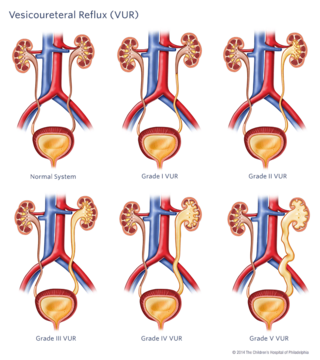What is vesicoureteral reflux (VUR)?
The kidneys produce urine, which travels down tubes called the ureters. The ureters empty into the bladder where urine is stored. During urination, the bladder contracts to empty and the muscle that holds the urine in (urethral sphincter) relaxes. Vesicoureteral reflux (VUR) occurs when urine in the bladder flows back into one or both ureters and often back into the kidneys. This may occur because of the position of the ureter in the bladder wall.
VUR is graded according to severity from grade 1 (mild) to grade 5 (severe).

The level of severity is determined by urine flow and the extent of the associated dilation.
- In Grade I VUR the urine flows back into one or both of the ureters but does not reach the kidney.
- In Grade II VUR urine flows back up to the kidney, but does not cause dilation of the renal pelvis.
- In Grade III VUR there is mild to moderate dilation of the ureter and the renal pelvis.
- In Grade IV VUR, the ureter, the renal pelvis and calyces are dilated.
- In Grade V VUR there is severe dilation of the ureters, renal pelvis and calyces.
Testing and diagnosis
Voiding cystourethrogram (VCUG) is used to confirm the diagnosis of VUR. During a VCUG a thin plastic tube, called a catheter, is inserted into the urethra (opening where urine comes out). The bladder is filled with a solution called contrast. While the bladder is being filled, X-ray pictures are taken to see if any of the contrast is traveling up the ureters. Children are asked to urinate once the bladder is full to see if any reflux occurs during the voiding phase. The VCUG takes 15 to 20 minutes.
Our Child Life Specialists will work with your child to help her with any stress and anxiety about the procedure. We do this through play, education, preparation and self-expression.
Signs and symptoms
- Reflux is often diagnosed after your child has been treated for a urinary tract infection (UTI) associated with a fever. About 30 percent of children who have a UTI with a fever will be diagnosed with VUR.
- Due to the increased use of prenatal ultrasounds, hydronephrosis (dilation of the kidneys) can be detected before birth. There are many reasons why a child’s kidneys may show dilation. If the degree of dilation is significant enough, we may recommend a VCUG to check for reflux.
- About 1 percent of healthy children have reflux; many will never have an infection or need treatment.
Risks
VUR does not cause a urinary tract infection. VUR allows bacteria that may be in the bladder to travel with the refluxing urine to the kidney. This can then cause a kidney infection.
In some children, once they have a kidney infection, “scarring” to the kidney can occur. Kidney scarring may cause high blood pressure. If both kidneys are scarred, kidney function may decrease. Pregnant women who have had significant kidney damage have an increased risk of complications.
Treatment
Each year, we evaluate and treat nearly 800 children with VUR. Our goal is to prevent kidney damage and kidney infections.
Lower grades of reflux will often resolve on their own, typically at 5 to 6 years of age. The goal is to prevent UTIs and kidney damage while the reflux is improving.
- Antibiotic prophylaxis: It has been the gold standard of care to keep children on a very low dose of antibiotics to inhibit the growth of bacteria (not to correct the VUR). This is called antibiotic prophylaxis. Antibiotics are continued until the risk of reflux is considered low.
- Bathroom habits and fluid intake: If your child is toilet-trained, her bathroom habits are very important. We encourage your child to empty her bladder every two to three hours, without holding. We assess for any signs of constipation which can contribute to the occurrence of a UTI. We also ask your child to increase the amount of water she drinks. All of these steps can help reduce the risk of bacteria growing in your child’s urine.
- Surgical intervention: Children who have grade 4 and 5 reflux or who have had repeated UTIs with concerns of kidney scarring, may require surgical intervention to fix the reflux.
Surgical options
Many factors should be considered when deciding about what treatment is best for your child: the severity of the reflux, whether the reflux is in one or both ureters, your child’s age and gender and the presence of kidney damage. We will thoroughly discuss all options with you and your child.
- Endoscopic surgery: This is usually an outpatient procedure under general anesthesia. During surgery a lighted tube, called a cystoscope, is inserted into the urethral opening to see inside the bladder — no incisions are made. A substance, called Deflux®, is injected into the area where the ureter enters the bladder. Deflux helps prevent urine from flowing back into the ureter.
- Ureteral reimplant: Under general anesthesia and through a lower abdominal incision, the ureter is reimplanted where it joins the bladder. Ureteral reimplantation corrects the anatomical abnormality that allows urine to flow back into the ureter. At CHOP this procedure can be done through a minimally invasive surgery (MIS) using a laparoscopic or robotic approach. This involves only a few small incisions instead of a larger lower abdominal incision. The benefits of MIS include a faster recovery, smaller incisions and a less noticeable scar. Most children go home the day after surgery.
Reviewed by: Division of Urology
Date: May 2011
Resources to help
Division of Urology Resources
Caring for a child with an illness or injury can be overwhelming. We have resources to help you find answers to your questions and feel confident in the care you are providing your child.

